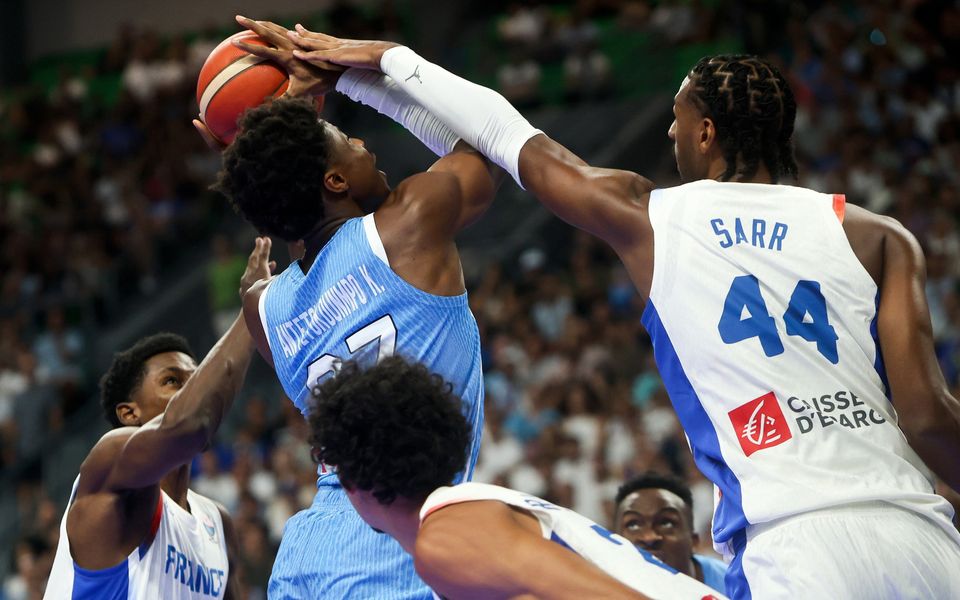As the EuroBasket 2025 tournament looms, all eyes were on Giannis Antetokounmpo, the Milwaukee Bucks superstar and Greece’s talisman, in the final preparation game against France on August 24, 2025. Expectations were sky-high for the two-time NBA MVP, especially after his explosive 25-point, 10-rebound performance in just 15 minutes against Latvia earlier in the preparation campaign. However, in this critical tune-up match against a formidable French squad, Giannis delivered a performance that left fans, analysts, and perhaps even his own team questioning his readiness for the upcoming tournament.
A Disappointing Statistical Output
Giannis, known for his dominance on both ends of the court, failed to live up to his “Greek Freak” moniker against France. In approximately 18 minutes of play, he managed only 12 points on a dismal 4-of-11 shooting from the field, including 0-for-3 from beyond the arc. His free-throw shooting, a persistent Achilles’ heel, was equally troubling, converting just 4 of 8 attempts. While he grabbed 7 rebounds and dished out 2 assists, these numbers pale in comparison to the double-double heroics he displayed against Latvia. More concerning were his 4 turnovers, which highlighted a lack of composure under France’s defensive pressure.
For a player of Giannis’ caliber, who averaged 30.4 points, 11.9 rebounds, and 6.5 assists on 60.1% shooting in the 2024-25 NBA season, this performance was a significant step backward. The friendly against France was a chance to assert his dominance against a team considered one of the favorites for EuroBasket, yet he appeared out of sync and unable to impose his will on the game.
Struggles Against France’s Defensive Scheme
France, even without key NBA stars like Victor Wembanyama and Rudy Gobert, showcased a disciplined and physical defensive approach that seemed to rattle Giannis. The French frontcourt, led by players like Guerschon Yabusele and Mathias Lessort, effectively neutralized Giannis’ drives to the basket. They employed a strategy of crowding the paint and daring him to shoot from mid-range or beyond, areas where he has historically struggled. Giannis’ inability to adjust was glaring—his three-point attempts were ill-advised, and his mid-range game was non-existent, forcing him into contested drives that often ended in turnovers or blocked shots (he was blocked twice).
Moreover, France’s guards, such as Dennis Schröder (playing for Germany but a comparable defensive pest), pressured Greece’s ball-handlers, disrupting Giannis’ ability to receive the ball in advantageous positions. Without the support of key teammates like Kostas Sloukas, who was rested for this game, Giannis was left to create offense almost single-handedly, a role that exposed his limitations when not surrounded by a fully cohesive unit. His frustration was evident, as he picked up a technical foul in the third quarter after arguing a non-call, further derailing Greece’s momentum.
Lack of Leadership and Impact
Beyond the numbers, Giannis’ overall impact on the game was surprisingly muted. As the unquestioned leader of the Greek national team, he is expected to elevate his teammates and set the tone, especially in high-stakes preparation games like this one. However, his body language suggested frustration rather than inspiration. There were moments where he appeared disengaged, particularly in the second half, where Greece’s offense stagnated, and France capitalized with a 12-2 run to pull away.
Greece’s head coach, Vassilis Spanoulis, has built the team’s strategy around Giannis’ versatility, but in this game, the lack of a clear Plan B when Giannis struggled was telling. His teammates, perhaps overly reliant on his usual heroics, failed to step up, and Giannis did little to rally them. Compare this to his performance at the Paris 2024 Olympics, where he averaged 25.8 points and carried Greece to their first Olympic appearance in 16 years, and it’s clear that something was off against France.
Fatigue or Rust?
One possible explanation for Giannis’ subpar performance could be fatigue or rust. After a grueling 2024-25 NBA season, where he played 44 minutes in a playoff overtime loss to the Pacers and earned All-NBA First Team honors for the seventh consecutive year, it’s possible that Giannis is not yet in peak form. His limited participation in earlier friendlies—missing games against Belgium, Montenegro, and Italy due to an insurance dispute with the Bucks and a strategic rest plan—may have left him underprepared for France’s intensity. While his 15-minute outburst against Latvia showed flashes of brilliance, sustaining that level against a deeper, more experienced French team proved challenging.
Additionally, Greece’s roster management raises questions. With key players like Sloukas and Dinos Mitoglou rested for the France game, Giannis was forced to shoulder an even heavier load, which France exploited. This lack of team cohesion could be a warning sign for EuroBasket, where Greece will face tough Group C opponents like Spain, Italy, and Georgia.
Fan and Analyst Reactions
The sentiment among fans, particularly on social media, was one of disappointment. One user noted, “Giannis and his copains les arbitres couldn’t get it done. France’s defence ate him up, and he looked lost out there.” While some of this criticism may be exaggerated, it reflects a broader concern about Giannis’ ability to perform against elite international competition when the stakes are high. Greek media, which hailed him as “unstoppable” after the Latvia game, were more reserved in their analysis of the France matchup, with some outlets questioning whether Greece’s reliance on Giannis could backfire in the tournament.
Analysts have also pointed out that Giannis’ performance against France mirrors some of his struggles in the NBA playoffs, where teams with strong interior defenders and disciplined schemes have limited his effectiveness. If Greece hopes to contend for a medal—their first since 2009—they’ll need Giannis to find ways to overcome such defenses, whether through improved playmaking, better shot selection, or greater leadership.
What This Means for EuroBasket 2025
This friendly against France was Greece’s final tune-up before their EuroBasket campaign begins on August 28 against Italy in Limassol, Cyprus. While it’s just an exhibition game, the loss raises concerns about Greece’s ability to compete with the tournament’s heavyweights. Group C is no cakewalk, with Spain, led by Santi Aldama, and a talented Italian squad posing significant challenges. If Giannis continues to struggle against physical defenses or fails to elevate his teammates, Greece’s hopes of ending their 16-year medal drought could be in jeopardy.
Moreover, the absence of players like Giorgios Papagiannis and Nikos Rogkavopoulos, coupled with the aging core of Sloukas and Kostas Papanikolaou, puts even more pressure on Giannis to perform at an MVP level. His performance against France suggests that he’s not yet in top gear, and with the tournament just days away, time is running out to find his rhythm.
Another wake-Up Call for the Greek Freak
Giannis Antetokounmpo’s lackluster performance against France was a stark contrast to the media hype. Some of us have been saying it all year. His struggles with efficiency, turnovers, and leadership, combined with France’s effective defensive strategy, exposed vulnerabilities that Greece must address before EuroBasket 2025. While it’s unfair to judge Giannis solely on one friendly game, this outing serves as a wake-up call. For Greece to succeed, Giannis needs to rediscover his MVP form, adapt to defensive schemes, and inspire his teammates to rise to the occasion. Otherwise, the Greek Freak’s EuroBasket dreams—and those of a nation—may fall short once again. And more importantly the myth of Giannis as a solution to any team’s problems when it counts. He just can’t seem to ever deliver.



